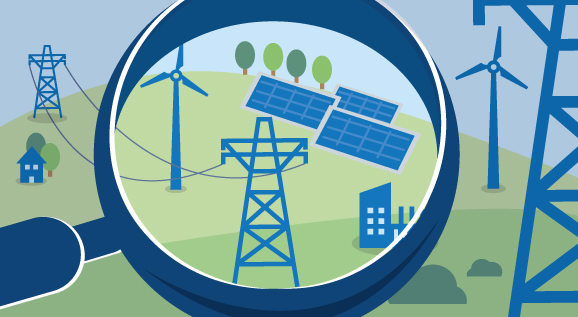Reactive power. How to keep up the voltage in the electricity grid?
It is crucial for the voltage in the electricity grid to be kept extremely stable to prevent damage to electrical appliances. This stability is created by feeding reactive power into the grid. Want to learn more? Here is how it works.
 © BMWi
© BMWi
Reactive power is used to ensure that the voltage is just right for electrical devices to work properly and without being damaged.
The current of electricity that flows in our grids brings energy to our consumers. It is important for this energy to have a voltage of precisely 230 V when it arrives. This leaves very little margin for fluctuations. Electrical devices are designed to be operated at 230 volts. Use a higher or lower voltage and your device might stop working or even break.
Reactive power is there to keep the voltage stable
Achieving a stable voltage level is hard work. After all, the transport of electricity also affects its voltage level.
But what exactly is reactive power? Scientifically speaking, it is the part of the current that does not transport energy. In any grid using alternate current (AC), as ours do, there is always reactive power. And there are many points in our grids where we need to feed in or take out the right amount of reactive power at the right time, so as to keep the voltage at the right level.
Like water for long-distance runners
Let’s make this a little easier to understand and think of the flow of current as a long-distance runner.Facing a long stretch of tarmac, the runner needs food that gives him the energy he’s going to use. But that’s not enough. To prevent his body from dehydrating, he also needs to drink something from time to time.
The water he drinks does not give him energy, it does not have a single calorie. Nevertheless, the runner needs to take a sip of water from time to time – or else he will collapse. His body needs the water as a kind of transport medium. In the same way, electric energy needs reactive power to be transported successfully.
Renewables are capable of producing reactive power
Until now, the bulk of the reactive power in our grids has come from the major power plants. These can simply adjust how much reactive power they want to feed in or take off the grid. They provide this service as a kind of auxiliary task, given that their main purpose is to feed power into the grid. The network operators keep the power plant operators informed as to how much reactive power they need at each point and at any given time. This ensures that the voltage is kept stable.
Renewables installations, such as solar or wind installations, can also provide reactive power. This is highly important, given that they are increasingly replacing large power plants, many of which are either shut down completely or only used at peak demand. For this reason, operators of renewables installations are now obliged to feed in certain amounts of reactive power into the grid. This allows the network operators to rely on many individual installations to provide the reactive power they need.
Developing solutions together
Whilst the work of a network operator has always included the task of keeping the voltage stable, there are still many questions that need answering: How should network operators choose which operator of an installation should provide what amount of reactive power? What is the process for requesting that reactive power? Are the operators of an installation providing reactive power entitled to payment for this service? If so, how should the amount be calculated and prices determined? These are just some of the questions that are currently being addressed by the Commission for the future provision of reactive power, a body established by the Federal Ministry for Economic Affairs and Energy. It brings together representatives of manufacturers and operators of power installations, network operators and consumers of electricity, who all seek to find answers to these questions.
The Commission held its first meeting on 17 September 2018 and plans to convene every three months. The next meeting is scheduled for 4 December. We will keep you informed.

